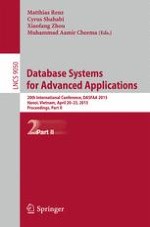This two volume set LNCS 9049 and LNCS 9050 constitutes the refereed proceedings of the 20th International Conference on Database Systems for Advanced Applications, DASFAA 2015, held in Hanoi, Vietnam, in April 2015.
The 63 full papers presented were carefully reviewed and selected from a total of 287 submissions. The papers cover the following topics: data mining; data streams and time series; database storage and index; spatio-temporal data; modern computing platform; social networks; information integration and data quality; information retrieval and summarization; security and privacy; outlier and imbalanced data analysis; probabilistic and uncertain data; query processing.
